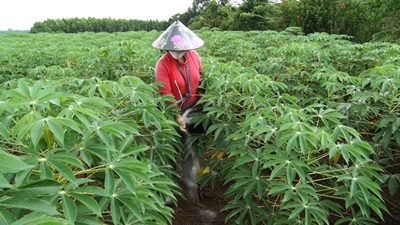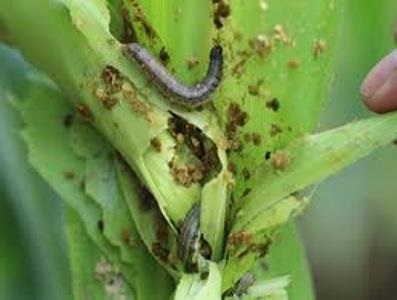
The cassava mosaic disease appeared more than a year
ago but it has not been able to be controlled up to now
Worrying pests
Cassava mosaic disease has appeared in the province
since June 2018, but until now this disease has not been completely prevented
but has developed complicatedly.
According to the provincial Department of
Agriculture and Rural Development, only two months after the first outbreak,
nearly 380 hectares of cassava in the province have been infected with cassava
mosaic disease. In late 2018, the cassava mosaic disease tended to gradually
decrease as farmers started to focus on prevention and control. However, in
early July this year the area infected with cassava mosaic disease has increased
dramatically. At present, statistics indicate that more than 450 hectares in the
province has been infected with cassava mosaic disease.
Cassava mosaic disease is caused by viruses and
transmitted by mealybugs or spread by pathogens in cassava stem cuttings. The
yield of the cassava plants that are infected with mosaic disease will drop
sharply and 100% of the yield will mostly be gone. More dangerously, the
varieties that are being infected are those producing a high yield and planted
by the province’s farmers like HL-S11, KM 140, KM 60, and SM 937-26.
Meanwhile, the epidemic of fall armyworms on corn
plants has appeared in the province since early May. Though fall armyworms have
just appeared, they have done enormous damage to corn growers. The Head of the
Plant Quarantine Station, Mr. Nguyen Trang Thinh, said: “Fall armyworms were
confirmed to appear in the northern provinces in February, 2019 for the first
time. Then, this harmful exotic species quickly spread to a lot of localities
throughout the country. The transmission route has not yet been known, but due
to the fact that fall army worms have a development of butterfly and can fly far
and spread widely. Worms tend to appear in the fields of the young corn plants
of 20 to 35 days, especially on the corn plants in the stage of bursting 3 to 7
leaves.
“Unlike other previous pests, fall armyworms have a
destructive power and a fast speed of causing damage to plants. The results of
surveys show that there is only one grown-up worm on each head of a corn plant,
but after only a few days they can bite and eat up all the young leaves at the
top and leave a huge amount of poo”, Mr. Thinh said.
In fact, after just over 2 months of its appearance,
fall armyworms have up to now inflicted more than 400 hectares of corn in the
province.
The risk of disease outbreaks is high
Director of the provincial Department of Agriculture
and Rural Development, Huynh Thanh Vinh, said: “For cassava mosaic disease and
fall armyworms, scientists have not been able to find out the most effective
specific remedy. For cassava mosaic disease, only cassava varieties with a high
resistance to diseases have been found but no disease-tolerant varieties.
Similarly, for fall armyworms recommendation is still preventing and using
manual measures to eliminate the disease as soon as it appears.

Fall armyworms on corn plants are still raging and
causing substantial losses to farmers
Assessing the risk of mosaic disease outbreaks, Mr.
Nguyen Trang Thinh said, the disease is likely to spread widely mainl due to the
fact that farmers have still used the old infected varieties of cassava for
cultivation and that a lot of farmers have still had their habit of re-using
cuttings in their fields to reduce costs whereas they are unaware that most of
the old varieties of cassava have been infected. If this issue continues, the
risk of outbreaks of this disease in the near future is very high.
According to the provincial Department of
Agriculture and Rural Development, fall armyworms are a new species of insects
that has appeared in the country for the first time and so no specific research
has been done and solutions have been put forward mainly based on reference
materials from abroad. Therefore, no precautionary effects have been brought
about. In addition, farmers have not taken all the precautionary measures in
their fields at one time and corn crops are cultivated at different times, which
results in the fact that after this corn field is sprayed and then grown-up
worms move to and damage other fields. Therefore, the area that is prevented
from this type of pests has not decreased considerably.
To minimize the level of damage caused by pests,
Deputy Director of Plant Protection Department at the Ministry of Agriculture
and Rural Development Le Van Thiet said, farmers are recommended not to use
cassava variety HL-S11 as this variety is very susceptible to diseases and will
be infected immediately after being grown, which will create great losses to
crop yield. Particularly, cassava variety KM94 is recommended to use by the
Ministry of Agriculture and Rural Development since it is a disease-tolerant
variety and despite the fact that though this variety has a low rate of flour,
the possibility of being sick won’t be great and its yield won’t decline
considerably. “In fact, the rate of infected cassava plants in the areas where
farmers use cassava variety KM94 falls dramatically”, said Thiet.
For fall armyworms, Mr. Thiet said, the most
attentive thing is that in the coming time farmers must visit their fields
regularly to detect and deal with outbreaks soon and effectively. The local
force of agriculture and plant protection officials should be active to conduct
inspections to early detect and prevent diseases effectively. In particular,
biological measures to prevent fall armyworms should be encouraged to use.
According to the Department of Agriculture and Rural
Development, to prevent cassava mosaic disease, the provincial Plant Protection
Department of disease-free cassava varieties KM140 and KM225 on an area of 92 ha
in Xuan Loc district (two models) and Long Thanh district (2 models).
These models have adopted such measures as using
yellow sticky traps to control mealybugs, spraying plant protection products to
prevent their, and having “mealybug and cassava samples” tested during the
monitoring period and before and after the harvest period to determine sick
cassava varieties. Also, during the piloting period cassava plants of four
models have developed and grown well; the effectiveness of sticky yellow traps
is from 10 to 214 bugs per trap; and no infected cassava plants have been found
out. At present, farmers have harvested 59 hectares with the average yield of 26
to 33 tons per ha and this source of disease-free varieties is expected to be
provided for production activities.
To prevent and control the epidemic, the Chairman of
the provincial People’s Committee has just sent documents on how to prevent and
control cassava mosaic disease and fall armyworms to the Departments of
Agriculture and Rural Development; Science and Technology; Information and
Communications; and Industry and Trade; Provincial Public Security; People’s
Committees of districts and cities; and provincial agencies, newspapers, and
radio and television stations.
Accordingly, to promote the prevention and control
of cassava mosaic disease and fall armyworms on corn plants, the Chairman of the
provincial People’s Committee assigned the provincial Department of Agriculture
and Rural Development to host and coordinate with concerned departments and
sectors and localities to monitor the cultivation of corn and cassava to provide
directions for varieties, crops, and farming methods against cassava mosaic
disease and fall armyworms; further conduct investigations to early detect the
areas infected with cassava mosaic disease and fall armyworms as well as
introduce precautionary and preventative measures according to the Plant
Protection Department’s technical process for prevention and control of cassava
mosaic disease and fall armyworms; direct the agricultural promotion system to
focus on disseminating propaganda information to and providing training in
prevention and control measures for farming households; don quick tests of plant
protection products with high efficiency against fall armyworms as a basis for
giving recommendations to farmers; investigate and discover varieties of cassava
with great resistance against mosaic disease to show farmers how to replace
severely-infected varieties; and continue to apply the models of making
disease-free cassava varieties and ensure that disease-free varieties are put
into cultivation.
Duy Minh (T. C)